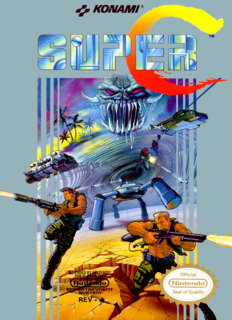Contra was an astonishingly popular side-scrolling shoot-'em-up, despite (what this reviewer believes to be) its minor flaws in presentations and its actually very simple gameplay. Not to sit on its laurels (when there was more money to be made), Konami produced a sequel that had much improved aspects over its predecessor, and aptly gave it the nomination of "Super".
Like the story of the first game, the one in the second is yet another excuse to have the player controlling one or both of the iconic heroes of the first game in another struggle against yet more terrible enemy armies bent on world domination/destruction. Other than a demo playback that occurs when the player leaves the main menu idle, there is hardly any story exposition before the player character is literally dropped into the heat of battle from the get-go.
The game makes certain that the very first level is terrifically high-octane, with plenty of targets to take out. The game is clearly meant for veterans of the first game, as the sheer number of enemies coming from behind, in front, above and below could have been overwhelming to those unused to hectic shoot-'em-ups.
The controls remained very much the same as in the first: the player character can still fire in eight directions and change direction mid-jump. With the increased level of chaos, however, it was more important than in the first game that the player mastered these techniques.
Konami had re-examined some of the features in the first game, such as the weapons that the player character may use. In the sequel, the Fireball gun is more useful than it was in the first game, due to having tremendously faster projectiles that can additionally split into explosive fragments that can deal a lot of splash damage. Unfortunately, it appears to be the only gun that had been upgraded, though it can now compete with the Spread gun more effectively to become the player's weapon of choice.
(Of course, choosing which weapon to use is still up to the player's preference. Due to the somewhat flawed design of weapons in the first game, many Contra veterans would favor the Spread gun over the improved Fireball gun. However, there are a sizable number of situations in Super Contra where the Spread gun is less effective.)
Enemies, however, pretty much remained how they once were in the first game: either fool-hardily charging away at the player or behaving like turrets. If they are not behaving in either way, then they are prancing and loitering around, making shots of opportunity at the player character as they pass by. There is still additional challenge to be gained from them, however, as the game spawns a lot of them into the screen.
Bosses are substantially more numerous in Super C than they were in Contra. It is a norm that every level will have at least one or two, with the later ones having almost always two or even three. They are also relatively more interesting to look at and fight than those in the first game, which this reviewer considered to be too rigid in their approach to fighting.
However, like in the first game, they had memorizable attack patterns and blind spots where their attacks cannot reach the player character so effectively. On the other hand, they fill the screen with substantially more projectiles than those in the first, thus requiring the player to be more alert the second time around.
(They also have more wide-spreading attacks, which can make co-op mode more challenging.)
The designs of the stages in Super Contra are mostly oriented around side-scrolling, though there are a few stages that have the player character moving around in a top-down view (and minus his ability to jump). The 'Base' stages, with their odd sense of depth, are missing in Super Contra (perhaps for the better, this reviewer believes).
The graphics appears to have been improved over that in Contra. Stages in Super Contra sport more themes than those in the first game and appear to have more colours and variation in hue. Sprites also benefited from the additional attention to detail.
However, due to the sheer number of sprites on-screen, there were times when the NES failed to generate them properly, causing contrast among sprites that are on-screen to fall. This flaw is especially bothersome when there are enemies that can fill the screen with many projectiles, all of which still kills the player character with a single hit.
The sound effects have not changed much since the first game. There are some new sound effects that are actually easter eggs of some sort (such as the sound-clip that plays whenever the player earns an extra life, and which sounds a lot like that in Super Mario Bros.).
(Speaking of extra lives, the player character may only have a maximum of up to four, which this reviewer found to be quite stifling.)
The music, like that of the first game, was still as upbeat as ever, perhaps even more so now that the developers had more time to focus on other aspects of the game other than its game engine (which remained the same one that was used for the first game). However, due to the greater number of sprites on-screen and thus the more cacophonous din, players would have found it hard to appreciate the music when it had to compete with sound effects for their attention.
Co-op two-players mode made a return in Super Contra, and it was still as fun as it was in the first game, if not more because of the greater numbers of enemies to annihilate and greater challenges in the sequel.
In conclusion, while one can say that Super Contra is more of the same, it has obvious improvements over the first game that made it more fun to play.

